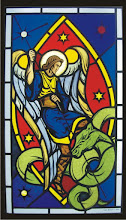 One of my favorite adventures in stained glass is glass painting (Figure A). Glass paint is essentially ground glass which, when applied to a piece of glass and heated in a kiln, becomes part of that glass. Glass painting serves two integral functions in stained glass: defining images and controlling the light. This is done by trace lines (opaque usually black painted lines) and matting (translucent shading) and each application must be fired separately in the kiln.
One of my favorite adventures in stained glass is glass painting (Figure A). Glass paint is essentially ground glass which, when applied to a piece of glass and heated in a kiln, becomes part of that glass. Glass painting serves two integral functions in stained glass: defining images and controlling the light. This is done by trace lines (opaque usually black painted lines) and matting (translucent shading) and each application must be fired separately in the kiln.St. Peter’s face, hands, and feet were fired six times for trace lines and various applications of bistre brown and flesh red to be complete. St. Peter’s garments as well received tracing and matting, largely to make sure that the light doesn’t burn too brightly through them. With all the pieces cut out (Figure B), I then need to hold them up to natural light to see what I've got. To help achieve a good balance of light and color, I mount all the pieces to a large glass using plasticine, and look for anything that seems harsh or inharmonious. (Figure C) The idea is that the saints will be a controlled outlet for the window's light, much like a faceted jewel.













